Reseña o resumen
Therapeutic Modalities for Musculoskeletal Injuries, Third Edition, provides comprehensive coverage of evidence-based therapies for athletic injury rehabilitation. Part of Human Kinetics' Athletic Training Education Series, the updated third edition presents the most current research regarding therapeutic modalities for athletic injuries and improves on previous editions through the alignment of the text's content with the National Athletic Trainers' Association (NATA) Athletic Training Educational Competencies. The result is a valuable resource for students preparing for NATA certification.
Therapeutic Modalities for Musculoskeletal Injuries, Third Edition, assists students and professionals in understanding the theoretical basis for and safe use of each modality. Readers will also find the text helpful in their research of the clinical literature to determine the effectiveness of each modality. In addition to explaining how to apply each therapy, this text addresses why and when each modality would prove safe and effective, providing readers with information for improved decision making regarding the utility of each modality in the injury management continuum.
Contents
Chapter 1. The Contemporary Use of Therapeutic Modalities
Legal Aspects of Therapeutic Modality Application: Practice Acts and Negligent Treatment
The Rehabilitation Plan of Care
Chapter 2. Psychological Aspects of Rehabilitation
Psychological Response to Injury
Maximizing Compliance With a Rehabilitation Plan of Care
Barriers to Successful Rehabilitation
Clinical Outcomes and Efficacy of Therapeutic Modalities
A Word About Placebo
Chapter 3. Tissue Injury, Inflammation, and Repair
Healing Tissues and Inflammation: An Overview
Acute Phase of the Inflammatory Response
Repair Phase of the Inflammatory Response
Maturation Phase of the Inflammatory Response
Chronic Inflammation
Swelling
Chapter 4. Pain and Pain Relief
What is Pain?
Pain and the Physical Exam
Pain Assessment
Transmission of the Pain Sensation
Pain Control Theories
Chapter 5. Persistent Pain and Chronic Pain
Where and How Pain Sensitivity Increases
Sources of Persistent Pain
Chapter 6. Impact of Injury and Pain on Neuromuscular Control
Integration of Components of Neuromuscular Control Into a Rehabilitation Plan of Care
Why Is Neuromuscular Control Lost?
The Role of Therapeutic Modalities in Restoring Neuromuscular Control
Chapter 7. Evidence-Based Application of Therapeutic Modalities
The Need for Evidence-Based Practice
Tools Necessary for Assessing Outcomes
Finding and Assessing the Evidence
Beyond the RCT Systematic Review and Practice Guidelines
Chapter 8. Cold and Superficial Heat
Energy Transfer
Cryotherapy and Cryokinetics
Superficial Heat
Heat and Cold: Contrast Therapy
Heat, Cold, and Contrast Therapy: Deciding What to Apply
Chapter 9. Principles of Electrotherapy
Basics of Electricity
Types of Electrical Current: Alternating, Direct, and Pulsatile
Parameters of Electrical Stimulation
Electrode Considerations
Chapter 10. Clinical Uses of Electrical Stimulation
Pain Relief: Transcutaneous Electrical Nerve Stimulation
Muscle Reeducation: Neuromuscular Electrical Stimulators
Iontophoresis and Stimulation of Denervated Muscle: Direct Current (DC) Stimulator
Wound Healing: Microcurrent Electrical Nerve Stimulator
Chapter 11. Ultrasound, Diathermy, and Electromagnetic Fields
Application of Acoustic Energy:Ultrasound
Efficacy of Ultrasound Therapy for Musculoskeletal Conditions
Application of Electromagnetic Energy: Diathermy and Pulsed Electromagnetic Fields
Efficacy of Diathermy and PEMF Therapy for Musculoskeletal Conditions
Stimulation of Fracture Healing
Chapter 12. Low-Level Laser Therapy
Electromagnetic Energy
Laser Production
Properties of Laser Light
Laser Classification
Laser Parameter Selection
Comparing Low-Level Laser Therapy Treatments
Biological Effects of Laser
Safety Considerations
Contraindications and Precautions
Chapter 13. Mechanical Energy
Manual Therapy
Is Manual Therapy Effective?
Traction
Intermittent Compression
Traction and Intermittent Compression: Effective Therapies?
Chapter 14. Treatment Plans for Acute Musculoskeletal Injuries
Management in the Acute Stage: Rest, Ice, Compression, Elevation
Modalities Used in Addition to RICE
Repair Phase
Maturation
Chapter 15. Neuromuscular Control and Biofeedback
Volitional Control and Biofeedback
Clinical Applications: Restoring Control of Volitional Contraction
Clinical Applications: Functional Progression
Learning Relaxation
Chapter 16. Clinical Management of Persistent Pain
Treating Persistent Pain
Diagnosis and Plan of Care Problems
Treating Chronic Pain
Glossary
Index
About the Authors

